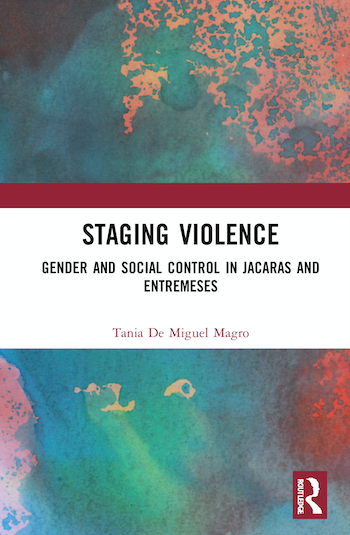Miguel Magro, Tania de. Staging Violence: Gender and Social Control in Jácaras and Entremeses. Routledge, 2021.

Have you ever laughed at a woman getting beaten on stage? Have you ever been amused by violence against men who cannot defend themselves in movies? Have you ever wondered why we are fascinated with representations of criminality in TV series?
Did you answer “Yes” to these questions, hoping that nobody finds out?
You might think that you are a terrible person or that there is something wrong with you for being addicted to these violent spectacles. You would prefer that family and friends do not access your streaming history on Netflix or Hulu. You would like to change the conversation and talk about other subjects that present you in a more positive light. Yet, you want to understand how something that horrifies you in real life can also make you laugh in fictional works.
You are not alone.
Most of us have been fascinated by representations of gender violence more than we would love to admit. This unsettling feeling of being attracted to something that must repel us is not a unique experience, and, certainly, is not a recent strategy by writers to engage younger audiences.
Did you know that there were hundreds of short theatrical pieces written, staged, and published in Spain during the sixteenth and seventeenth centuries that focus on gender violence? Yes, there are. They are funny, engaging, and relevant to contemporary society.
It seems that authors from the period understood that humor can help us deflect serious issues. In the world of early modern Spanish short theater, women are beaten, men are humiliated, homosexuals are ridiculed, and prostitutes are ostracized. The world staged in these pieces is not idealized. Rather, it puts gender violence on the stage.
To understand gender violence, Tania de Miguel Magro has published Staging Violence: Gender and Social Control in Jácaras and Entremeses. In this book, she examines a variety of texts dispersed in archives, single editions, and translations. She explores female victims, aggressive women, men, effeminate men, prostitutes, cross-dressers, impotent men, and people who do not conform to the gender binary of female/male and how they are portrayed in early modern Spanish short theater.
Do you know what is great about this book? It offers a historical, legal, and literary context that helps the reader have a better understanding of the period. So, even if you don’t know anything about Spanish theater of the sixteenth and seventeenth centuries, you will learn a lot.
The book is divided into two main sections: violence against women and violence against men. These two sections are divided into three chapters. This division gives unity to the book as chapters dialogue with each other from different perspectives regarding gender violence. The upside world of early modern Spanish short theater in which everything can happen is harmoniously organized to guide readers.
One example of violence against women is Agustín Moreto’s El hijo del vecino. In this short piece, spectators find a defense of the virtues of wife battering. Esnefa talks a lot and has many lovers. However, she falls in love with Don Blas, a man who hits her so hard he breaks her teeth. The author puts this desire to be beaten in context: “There is in El hijo del vecino a clear connection to the Catholic tradition of using penance and mortification of the flesh as a path to obtaining salvation” (76). This representation of the desire to be beaten does not necessarily equal the author’s view on gender violence.
One example of violence against men appears in Antonio de Zamora’ Los gurruminos. In this short piece, the mayor drafts an edict against gurruminos, a husband who indulges his wife in excess. What is interesting about this short piece is that the one launching the campaign is a gurrumino himself. Gurruminos are sentenced to be part of a parade: they are going to be publicly shamed. The author argues that “Violence has served in this entremés to bring out the deviant masculinities it was trying to repress” (167). Los gurruminos dismantles essentialist interpretations of gender and authority.
One example of non-binary violence can be found in the chapter devoted to the fictional character of Juan Rana. Interpreted by the famous actor Cosme Pérez, Juana’s gender is hard to define. As the name implies, there is an amphibious aspect in the sense that he/she/they is neither a man nor a woman. His popularity made playwrights from the period compose several short pieces. In most of these pieces, the character ends beaten up on stage. The author posits that “Rana’s beatings could be interpreted as hazing rituals that incorporate the outsider and thus open the possibility of tolerance toward those who do not fit into traditional categories” (212). Certainly, these pieces open up a space to discuss gender.
And how does the author address the issue of humor in staging gender violence?
Tania de Miguel Magro reminds us that “we cannot oversimplify humorous representations of violence” (2). The author asserts that “attitudes toward gender and violence were extremely complex and diverse” (2). We might laugh at inappropriate or politically incorrect jokes, but this does not mean that we necessarily support or encourage violence. In other words, the “audience can laugh at the absurdity of marital quarrels and at the same time be aware of the painful everyday reality they portray” (21). Gender violence triggers many and conflicting reactions.
Do you feel better at this non-judgmental approach to humor in fictional works that portrayed gender violence? I hope so.
In summary, this book…
- provides historical, legal, and literary context to early modern Spanish short theater.
- organizes different representations of gender violence (i.e., male/female/non-binary).
- contrasts short theater to other theatrical genres such as the more traditional comedia.
- invites us to reflect critically about humor in representations of gender violence.
- offers a textual analysis of short plays with plots centered on gender violence.
I want to finish this post with two recommendations.
First, I would like you to start reflecting on representations of gender violence in fiction:
- What are your thoughts when you see violence in theater, movies, or TV series?
- How does the author approach the topic? Is it serious? Funny? Indifferent?
- What can we learn from this representation?
Second, I would like that you read this book:
- Can you buy it for your personal library?
- Can you convince a librarian to add the book to the university or local library?
- Can you ask someone to buy it for you as a gift?
This book review includes a link as part of the Amazon Affiliate Program. As an Amazon Associate I earn a commission from qualifying purchases.
